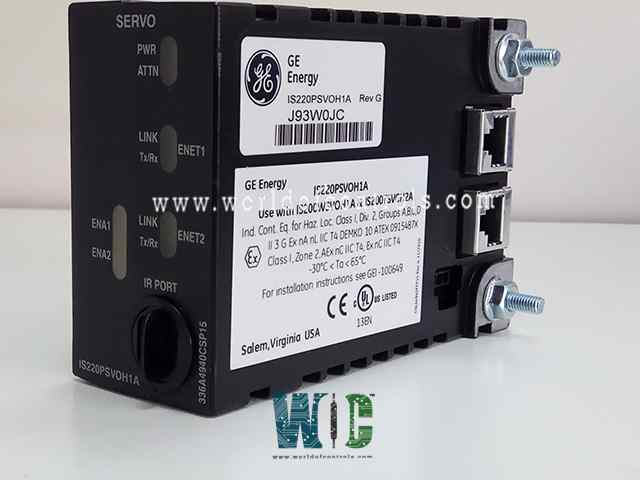
World Of Controls understands the criticality of your requirement and works towards reducing the lead time as much as possible.
IS220PSVOH1A, REV F - Servo Control I/O Module is available in stock which ships the same day.
IS220PSVOH1A, REV F - Servo Control I/O Module comes in UNUSED as well as REBUILT condition.
To avail our best deals for IS220PSVOH1A, REV F - Servo Control I/O Module, contact us and we will get back to you within 24 hours.
SPECIFICATIONS:
Part Number: IS220PSVOH1A, REV F
Manufacturer: General Electric
Product Type: Servo Control I/O Module
Function: I/O Module
Series: Mark VIe
Number of outputs: 2
Power supply voltage Nominal: 28 V DC
Pulse rate accuracy: 0.05%
Magnetic PR pickup signal generates: 150 V
Operating temperature: -30 to +65°C
Size: 8.26 cm high x 4.19 cm
Input Filter: Hardware Filter, 4 ms
Technology: Surface-mount
Availability: In Stock
Weight: 0.8kg
Repair: 3-7 days
Country of Origin: USA
Manual: GEH-6721D
FUNCTIONAL DESCRIPTION:
IS220PSVOH1A, REV F is a Servo Control I/O Module manufactured and designed by General Electric as part of the Mark VIe Series used in GE Distributed Turbine Control Systems. The PSVO I/O pack serves as the electrical interface between one or two Ethernet I/O networks and a TSVO servo terminal board. It includes a common processor board used across all Mark VIe distributed I/O packs and a dedicated I/O board for servo functions. Working alongside the adjacent WSVO servo driver module, it manages two servo valve position loops and supports five selectable output current levels ranging from 10 to 120 mA DC. The pack also provides LVDT excitation, accepts eight LVDT feedback signals, and receives two pulse rate inputs from fuel flow meters. It features dual RJ45 connectors for Ethernet input and receives 28 V DC power from the terminal board. Outputs are delivered via a DC-62 pin connector that interfaces directly with the terminal board. LED indicators offer visual diagnostics, while an infrared port supports local serial communication for diagnostics.
COMPATIBILITY:
The PSVOH1A I/O pack is specifically designed for use with the TSVCH1A servo terminal board, ensuring reliable performance in servo valve control applications. However, it is not compatible with the DIN-rail mounted DSVO board or the TSVOH1B terminal board. Using it with incompatible boards may result in improper operation or system errors.
INSTALLATION:
OPERATIONS:
The processor board connects to an acquisition board tailored to the I/O pack function. When input power is applied, the soft-start circuit gradually increases the voltage on the processor board. Local power supplies are activated, and the processor reset is released. The processor runs self-test routines and loads application code from flash memory specific to the I/O pack type. It then verifies board ID information to ensure proper alignment between the application code, acquisition board, and terminal board. If the match is correct, the processor requests a network address using DHCP and the terminal board's unique identification. After Ethernet initialization, the processor programs the on-board logic, executes the application, and allows the acquisition board to begin operation.
WOC has the largest stock of GE Distributed Control System Replacement Parts. We can also supply unused and rebuilt backup with a warranty. Our team of experts is available around the clock to support your OEM needs. Our team of experts at WOC is happy to assist you with any of your automation requirements. For pricing and availability on any parts and repairs, kindly get in touch with our team by phone or email.
What types of connections and interfaces does the module support?
The Servo Control I/O Module typically supports several high-density and specialized connectors. These include 48-pin J2 connectors for WSVO servo driver assemblies, Ethernet ports (ENET1 and ENET2) for communication, and a high-density DC-62 pin connector for interfacing with the terminal board.
What is the purpose of the Ethernet ports, and how is network redundancy handled?
The module includes two Ethernet ports—ENET1 and ENET2—which provide communication paths between the control packs and the system network. These ports are used for real-time data exchange, command transmission, and status monitoring.
What are WSVO servo driver assemblies, and how are they installed?
WSVO servo driver assemblies are modular units that interface directly with the servo motors to control their motion. These drivers receive command signals from the control packs and regulate current, voltage, and torque output to the motors. They are installed by plugging them into the J2 48-pin connectors on the terminal board.